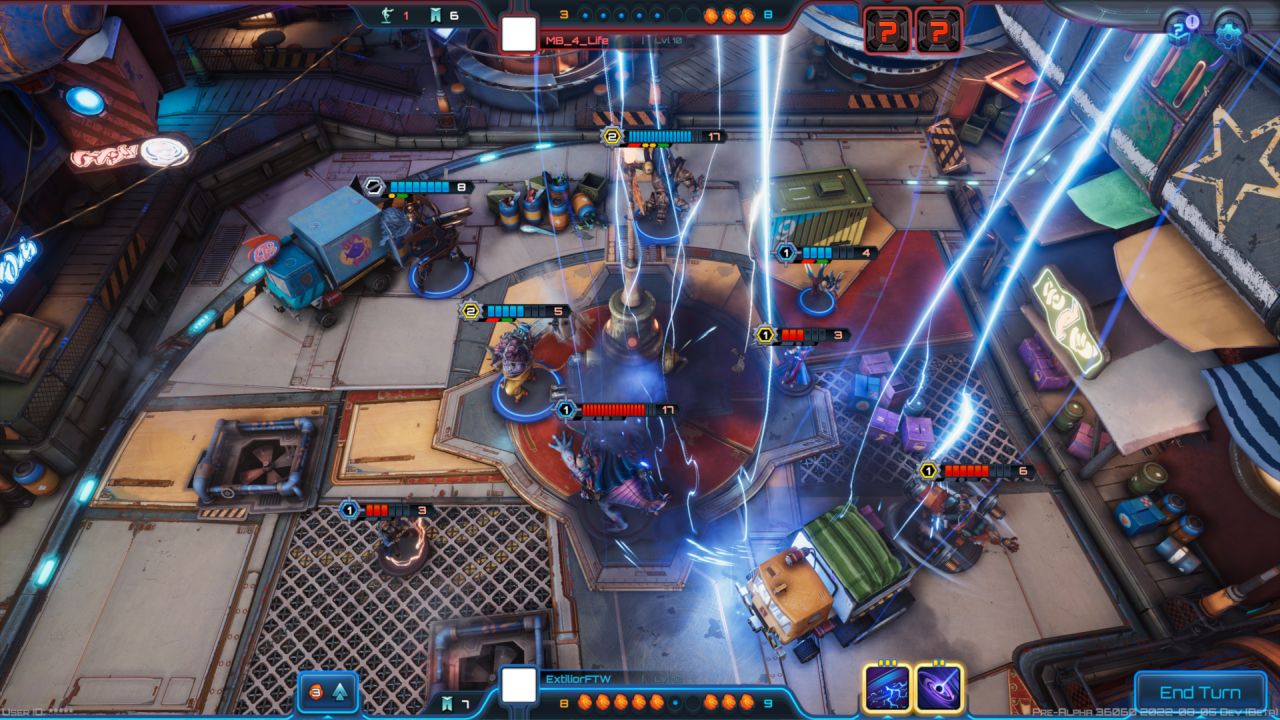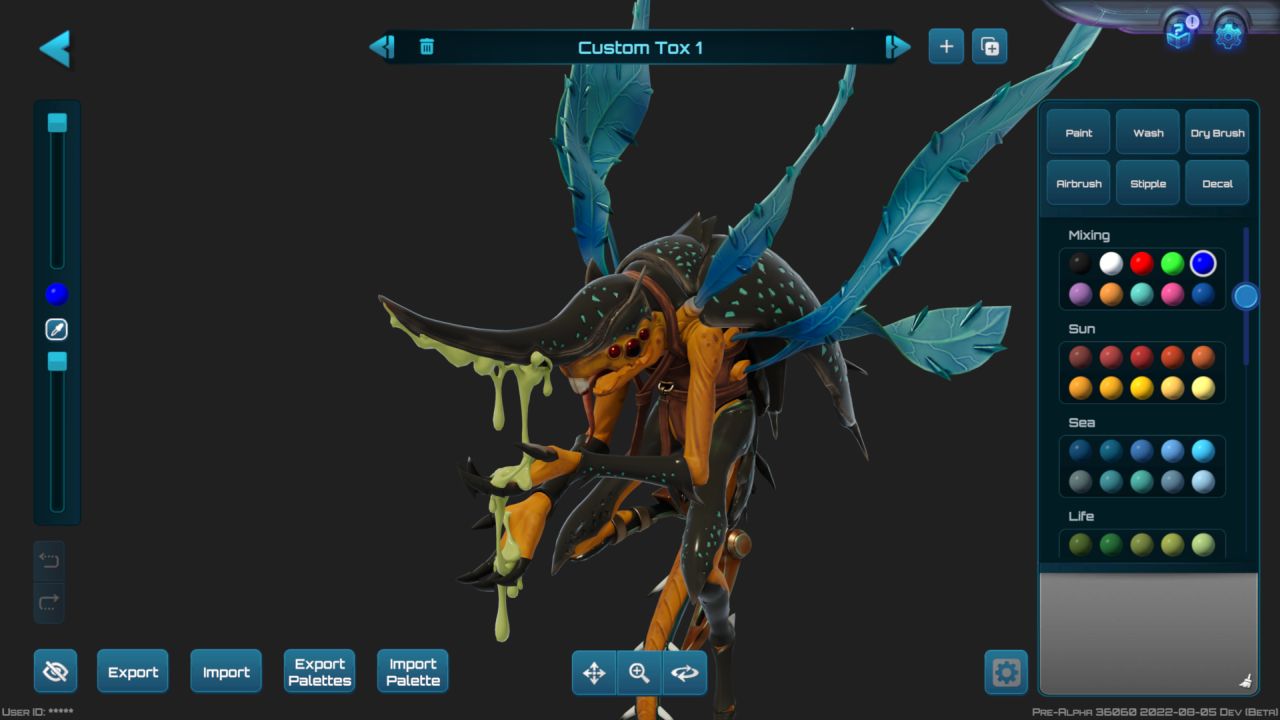I admit it was a trick question, but look, I’m a genuinely big fan of devs doing a completely different project after a successful game. I also know a whole lotta people who love painting plastic fighters in cool colours, carefuly placing them on a tabletop, and slowly pushing them into other plastic fighters in different colours. I’m absolutely sure that Unknown Worlds will make a very good version of a digital tabletop strategy game. I must admit, though, that whenever a video game like this emerges, I sort of wonder why tabletop-thusiasts would buy it instead of more actual miniatures. In an hour long, hands-off preview presentation, I got to see just how tabletoppy Moonbreaker is. The board you’re on has landscaped features designed to look like a custom build you’d see in Games Workshop on a Friday night; the water looks like poured expoxy resin, and the banks are covered in plants made of that grassy dust stuff. It’s a sort of labour of love for Unknown Worlds, a digital exploration of a favourite hobby. And if, like me, your impression of most tabletop games is from Warhammer 40k, where the ruins are mostly different flavours of rock and mud, Moonbreaker is an explosion of tropical colour and space pirates. Your team is a group of 10 crewmembers, plus one captain, who are the hero characters of the game. When you start a battle - either vs AI, PVP through matchmaking or private rooms, or a kind of roguelike single-player mode called Cargo Run - only the opposing captains are on the board. You then get the chance to call down a crewmate on your turns, each costing an amount of Cinder, the in-game resource that governs things like special moves. The max size of the team you can field is six, plus your captain, so once you reach that limit you have to wait for a unit to be destroyed to call someone else down. The captains shown had quite clear strengths and weaknesses, so the stripped back start gives you a chance to scope out your opponent and do some quick tactics thinking. It feels more reactive than having a battlefield already stacked with your different units. In the preview, for example, the AI was playing the captain Astra, a 12 year old triumphantly riding a purpley-pink space toad. She’s a strong ranged attacker, but is liable to get rushed. Community Manager Donya Abramo was playing Extilior, a big golden robot who Abramo described as very defensively strong, especially up close. The final captain shipping with the game, who we didn’t see in action, is a Han Solo-esque smuggler who is actually a hologram. The miniatures are sort of semi-animated. They’re not articulated, but they might have a bit of flavour animation. Astra’s ranged attack saw her toad-monsters tongue flick out, and the whole miniature rocked on its base - but no other part of it moved. To counter Astra’s, Abramo called down Maximus, a quick little gunslinger type who, if he lands a successful hit, gets a second chance to move. Maximus was able to fire off a shot and then quickly duck back behind some hard cover (an imposing jade statue), his base hopping and spinning along as he stayed motionless on top of it. It’s worth noting that, like Warhammer, Moonbreaker doesn’t use a grid system, so you can move more freely within your character’s range. This is what, potentially, allows for a more interesting map design. Rather than obstacles and topography fitting neatly into boxes, the first map we saw had almost no straight lines, and sort of like it might be a small plaza in an alien city, shaped like a bit like a leaf and made of swiling sections of polished green and off-white. Stairs led off the sides, and as well as the hard cover provided by the jade statuework - which blocks attacks - there was soft cover in the form of flower planters, not shielding units entirely but reducing accuracy. Another was an industrial map on a sandy planet, with a machine crushing bag of trash, and cover from carts of junk that had fallen over. There’s potential for a lot of different outcomes, with variables not just from the map and units (we saw a smuggler character, Rickety, take out an enemy unit and himself, because his attacks carry a small percentage chance to backfire) but also ship assists. These moves take a certain number of turns to power up, and includ big offensive canon blasts. But if, for example, you’re playing a slower character like Extilior, you might want to use the Stim Burst to boost his movement. Rather than a kind of ongoing logic puzzle like Into The Breach, or the somewhat frantic battle of reaction in RTS games, this is landing somewhere in the middle. Which is probably the point. And, oh yes, Brandon Sanderson is here too, somehow? Yes, the Moonbreaker universe was developed by everyone’s favourite Mormon epic sci-fi and fantasy author (I admit this is possibly an overly specific field). What you’re fighting around and over are a series of fairly small moons, clustered together around a sun, each with a core of cinder. Since cinder is so useful people want to drill down into them moons. Hence the name. This concept, as well as the different cultures and the stories for many of the characters, come from Branderson. Moonbreaker is shipping with 50(ish) of these characters, but will get seasonal updates that each come with a new series of crewmates, typically in clusters belonging to the different moon cultures. And, obviously, you can paint them all. I saved this to last ‘cos I thought it looked really cool. All of the characters do come with a default paint job, which was done by professional miniature painters working with the in-game tools, but of course you can do your own custom version. There are suggested paint colours for the different cultures, but you can go wild, and there are really useful tools. You can do washes, you can airbrush, you can stipple or dry brush for different effects. You can also auto-mask, so if you want to quickly paint an entire gun pink without getting any of it on the character’s gloves, you can. At any point in the game you can pick up a miniature and admire the paintwork of your opponent. Moonbreaker looks like a complex game, and I’d wager one that Unknown Worlds want to support as an ongoing thing. A game as a service, basically. It has an in-game currency for cosmetics and booster boxes for new characters, and while the early access is paid, (they’re still working out exactly how much of the in-game currency you’ll get once you buy in) I don’t know what the monetisation style of Moonbreaker will be, if any, when it reaches 1.0 status. I do know that each season will have its own kind of event track, totting up the XP you get by playing the game and rewarding you with booster packs of characters, decals, custom paint jobs, and so on. Every season is accompanied by a fully voiced audio dramas, too. It’s a universe they clearly want people to invest in, spiritually if not fiscally. And I have to say, I was impressed. It looks great. The dry brushing thing in particular really blew my mind. But I still can’t shake that doubt about who this is for. Despite the characters all looking unique and fun, if you really like tabletop miniatures… don’t you just prefer playing with and painting tabletop miniatures? Genuine question. Answers on a postcard.



